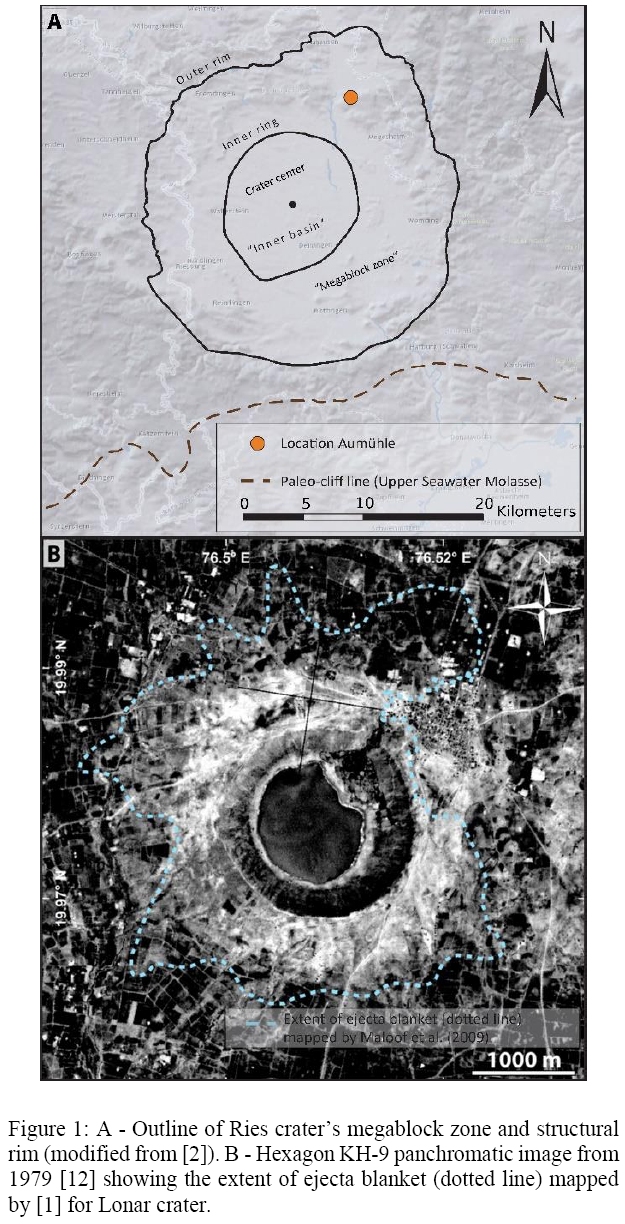Impact excavation processes studied by Ground-penetrating radar (GPR) on terrestrial analogues for Mars.
- 1Albert-Ludwigs-University Freiburg, Institute of Earth and Environmental Sciences, Geophysics, Freiburg, Germany (jakob.wilk@geologie.uni-freiburg.de)
- 2Albert-Ludwigs-University Freiburg, Institute of Earth and Environmental Sciences, Geology), Freiburg, Germany
Introduction: Recent studies have shown some terrestrial impact structures to possess ejecta ramparts similar to martian impact craters, e.g. Lonar crater in India [1], and Ries crater in Germany [2]. Nonetheless, the formation of ejecta rampart structures is still controversial and several formation models have been proposed to explain the rampart formation process (see review by [3]).
The 26 km diameter Ries crater in Germany is a relatively pristine, complex impact crater characterized by two distinct ejecta lithologies. The built up of the continuous ejecta blanket by a polymict lithic breccia, called Bunte breccia, generally composed of mainly unshocked to weakly shocked sedimentary target clasts, minor amounts of crystalline basement fragments, and reworked surficial sediments [4], overlain by patches of shocked and partly melted crystalline basement material, called suevite [6, 7], is well exposed in several outcrops within the outer rim (see Aumühle Fig.1A).
This study focuses on the trackability of the ejecta layers transition and the documented thickening of the ejecta deposits [2] by ground-penetrating radar (GPR) in Aumühle. We plan to assess the capability of the GPR method for an analogue of particular importance, Lonar crater. Since, Lonar crater occurred in basalts of the Deccan Plateau [5,6], it represents a target lithology that is comparable to the massive basaltic plateaus on Mars.
Methods: The GPR study for Ries crater is investigating the subsurface contact between Bunte breccia and suevite with a bi-static 50MHz-200MHz antenna configuration for constant separation traversing profiles. The spatial arrangement of the profiles in grids allows a reconstruction of the boundary layer (contact plane). In addition, the attenuation of the radar signal has to be studied for layered ejecta deposits, as present in Aumühle, and in a not yet determined basaltic analogue.
Studies prospective: The continuous ejecta blanket of Lonar crater extends to an average distance of 1 km from the crater rim (Fig.1B) and is reported to be divided into two ejecta types as well [8, 9, 10]. An apparent thickening of the ejecta deposits is observable in its distal parts similar to rampart structures on mars [1, 11]. If the Ries study provides a feasible concept, this study will be extended to the distal ejecta parts at Lonar.
Acknowledgments: We thank the “Wissenschaftliche Gesellschaft, Freiburg im Breisgau” for funding the field trip to Ries crater.

References: [1] Maloof et al. 2009 Geological Society of America Bulletin 122:109–126. [2] Sturm et al. 2013 Geology, 41, 531-534. [3] Weiss and Head 2018 Meteoritics & Planet. Sci., 53, 741-777. [4] Hörz et al. 1983 Reviews of Geophysics and Space Physics, 21, 1667-1725. [5] Osae et al. 2005 Meteoritics & Planet. Sci., 40, 1473–1492. [6] Stöffler 1977 Geologica Bavarica, 75, 443-458. [7] Von Engelhardt 1997 Meteoritics & Planet. Sci., 32, 545-554. [8] Fredriksson et al. 1973 Science, 180, 862–864. [9] Kumar et al. 2014. Journal of Geophysical Research: Planets 119, 2029–2059 [10] Kiik et al. 2020 Geosciences 10, 417. [11] Wulf et al. 2019 Earth. Planet. Sc. Lett., 506, 209-220. [12] USGS Earth Explorer website.
How to cite: Wilk, J. and Wulf, G.: Impact excavation processes studied by Ground-penetrating radar (GPR) on terrestrial analogues for Mars., European Planetary Science Congress 2021, online, 13–24 Sep 2021, EPSC2021-799, https://doi.org/10.5194/epsc2021-799, 2021.

